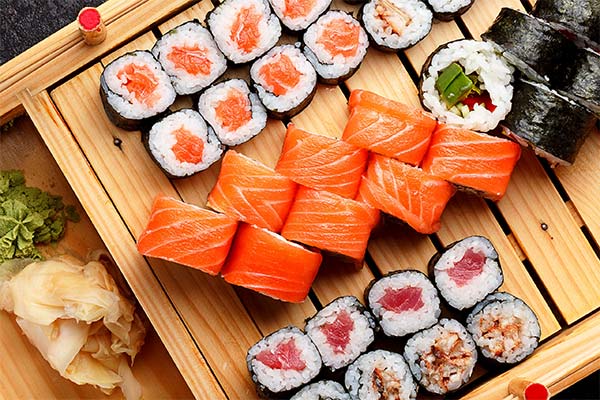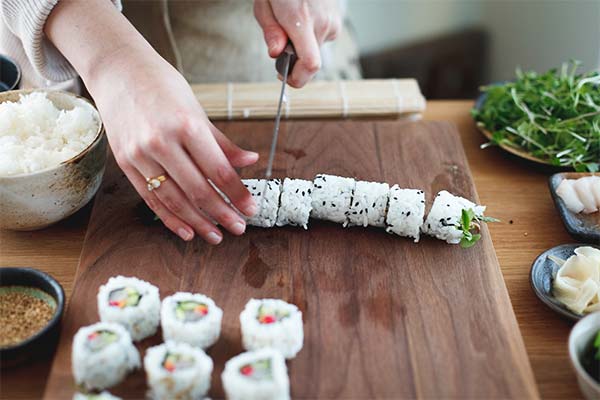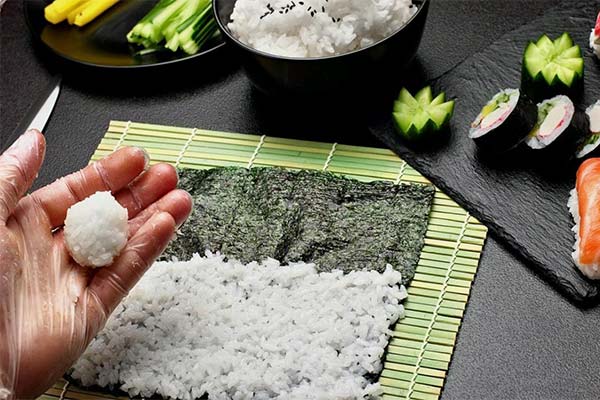Sushi and rolls have long been a favorite dish on any table and not just Japanese. Although their homeland is the country of the rising sun. Many people like to eat sushi or rolls, but not everyone knows how they differ from each other.
What are sushi and rolls
Before we move on to look at the differences between the two dishes, it’s worth familiarizing ourselves with the concepts.

Sushi – made from rice, it is boiled together with the addition of vinegar to make the product sticky. After that, lumps are formed. Various sea ingredients are placed on top, it can be some fish, eel or shrimp.
Rolls are twisted rolls of nori seaweed, rice, and toppings that are cut into small portions.
Types
First, it’s worth looking at the types of rolls; in fact, there are quite a few:
- Yaki-Maki – these are baked in the oven and served hot.
- Nori-Maki – the most common type with cucumber added, they have nori on top.
- Uro-maki – In this version, the seaweed is on the inside, the most common type is Philadelphia.
- Tamaki – related to classic rolls, but larger in size and containing large amounts of toppings.
- Futomaki – In these rolls, the filling consists of several ingredients at once.
- Hosomaki – the filling must include avocado.
Sushi cannot boast a great variety, they are divided only by the type of stuffing, which can consist of fish, octopus or shrimp. Still, some restaurants may offer such options:
- Nigiri sushi is the traditional kind, the rice is rolled into a ball and shrimp, octopus meat or a slice of sea fish is placed on top.
- Tamago sushi – a Japanese omelet is placed on a rice ball and the whole thing is tied with a seaweed ribbon.
- Chirashi sushi – these sushi are an unconventional kind, rice seasoned with vinegar is spread in small bowls, and raw fish and sashimi are placed on top.
What’s the difference between rolls and sushi
If we talk about the similarities of the two Japanese dishes can be distinguished by a single homeland, they are a great substitute for fast food, while containing useful elements and quickly cooked. Now it is worth considering the main differences:
Exterior Features
The main ingredient for sushi is rice, with seafood and seasonings taken as additives. On the surface, they look like a rice ball with a filling on top. Sometimes it is tied with a strip of seaweed.
The rolls are wrapped in nori, twisted into a cylinder, and cut in portions.
Components
In the two dishes, the main ingredient is rice. Salt, sugar, and vinegar are also added to both rolls and sushi. But the filling will be different.
In sushi, only seafood such as salmon, eel, shrimp, etc. is put in.
Rolls have a wider variety of toppings, such as cheese, cucumber, avocado, or any other vegetable mix. Seafood can be replaced by chicken or bacon. Some diners even add fruit. But the constant ingredient of the roll is seaweed, which is placed under the rice.
There may also be differences in the way the dishes are served. But the unifying extras are pickled ginger and wasabi sauce with a spicy flavor. And soy sauce is always included to keep the rice from seeming too dry.
How to make rolls and sushi
It is quite possible to prepare sushi and rolls at home. The main thing is to master some skills and acquire certain equipment.
Rolls
To make rolls you need a special bamboo mat, which is sold in specialized stores. Then stock up on clingfilm and a sharp knife.

When choosing rice, preference is given to the special Japanese type, but in the absence of the latter, local round-grain rice will do. Be sure to buy a nori leaf, nowadays it is not a problem to find this ingredient.
Rice Cooking Sequence for Rice Rolls
First, prepare the following ingredients for the standard recipe:
- Rice – 250 g.
- Salt – ½ tsp.
- Sugar – ½ tbsp.
- Rice vinegar – 2 tbsp.
Cooking sequence:
- Rice should be rinsed in running water several times until all the starch comes out and the water is clear.
- Transfer the rice to a pot and pour water at a ratio of 1:2.5. Bring it to a boil, then turn down the heat and cover.
- Cook for up to 10-15 minutes, then remove the pot from the heat and leave its contents under the lid for 10 minutes.
- While the rice is cooking, deal with salt, sugar and vinegar. They should be mixed and put on low heat until the salt and sugar in the liquid is completely dissolved.
- Now the rice needs to be mixed with the vinegar dressing.
After that, the rest of the ingredients are added and the whole thing is twisted into a roll, which is cut into small pieces.
Sushi
Sushi can be prepared at home, but you should understand that it will not turn out exactly like in a restaurant. After all, they are prepared there by specially trained people who know all the subtleties of cooking sushi.

But something similar can be created. Rice needs to be boiled so that it is sticky. After soaking in vinegar, it is easily formed into a ball. The filling is taken at your discretion. To form the sushi, you need to wet your hands in water and give the rice the desired shape. Fish, shrimp or other seafood is placed on top, then it is all fixed with a strip of seaweed.
Where to order
If you are not a fan of experimenting with cooking, it is best to order rolls and sushi. If previously you had to go to special Japanese establishments, but now in many cafes and restaurants you can find a variety of options for this food on the menu. Almost everywhere there is delivery. Sushi and rolls can be ordered in Krasnodar on the website prosushi.ru. This is the easiest and most affordable option. You can also visit specialty stores or go to themed apps through your phone.
Keep in mind that in terms of price, rolls will be cheaper than sushi. If the cost of rolls is estimated at 6-8 pieces, the payment for sushi goes for one unit.
The energy value of sushi is defined as 70 kcal per 100 g. Philadelphia is considered to be the heartiest because it has the largest amount of seafood.
The caloric value of rolls is difficult to determine, it will depend on the toppings.
In addition to the taste benefits, both rolls and sushi have a whole stock of valuable elements and vitamins.
The articles on this site are for information purposes only. The site administrators are not responsible for attempting to apply any recipe, advice or diet, nor do they guarantee that the information provided will help or harm you personally. Be cautious and always consult a doctor or nutritionist!
*All products recommended by thefirstdoc.com are selected by our editorial team. Some of our articles include affiliate links. If you buy something through one of these links, you help us earn a small commission from the seller and thus support the writing of useful and quality articles.




